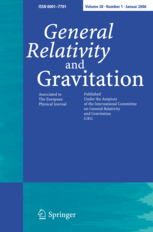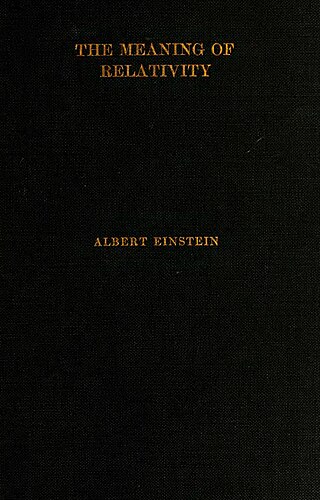
The theory of relativity usually encompasses two interrelated physics theories by Albert Einstein: special relativity and general relativity, proposed and published in 1905 and 1915, respectively. Special relativity applies to all physical phenomena in the absence of gravity. General relativity explains the law of gravitation and its relation to the forces of nature. It applies to the cosmological and astrophysical realm, including astronomy.

In academic publishing, a scientific journal is a periodical publication intended to further the progress of science, usually by sharing findings from research with readers. They are normally specialized based on discipline, with authors picking which one they send their manuscripts to.
In physics, the principle of relativity is the requirement that the equations describing the laws of physics have the same form in all admissible frames of reference.
The Astrophysical Journal (ApJ) is a peer-reviewed scientific journal of astrophysics and astronomy, established in 1895 by American astronomers George Ellery Hale and James Edward Keeler. The journal discontinued its print edition and became an electronic-only journal in 2015.

Academic publishing is the subfield of publishing which distributes academic research and scholarship. Most academic work is published in academic journal articles, books or theses. The part of academic written output that is not formally published but merely printed up or posted on the Internet is often called "grey literature". Most scientific and scholarly journals, and many academic and scholarly books, though not all, are based on some form of peer review or editorial refereeing to qualify texts for publication. Peer review quality and selectivity standards vary greatly from journal to journal, publisher to publisher, and field to field.
Physical Review is a peer-reviewed scientific journal established in 1893 by Edward Nichols. It publishes original research as well as scientific and literature reviews on all aspects of physics. It is published by the American Physical Society (APS). The journal is in its third series, and is split in several sub-journals each covering a particular field of physics. It has a sister journal, Physical Review Letters, which publishes shorter articles of broader interest.
BioMed Central (BMC) is a United Kingdom-based, for-profit scientific open access publisher that produces over 250 scientific journals. All its journals are published online only. BioMed Central describes itself as the first and largest open access science publisher. It was founded in 2000 and has been owned by Springer, now Springer Nature, since 2008.

The Max Planck Institute for Gravitational Physics is a Max Planck Institute whose research is aimed at investigating Einstein's theory of relativity and beyond: Mathematics, quantum gravity, astrophysical relativity, and gravitational-wave astronomy. The institute was founded in 1995 and is located in the Potsdam Science Park in Golm, Potsdam and in Hannover where it closely collaborates with the Leibniz University Hannover. Both the Potsdam and the Hannover parts of the institute are organized in three research departments and host a number of independent research groups.

Classical and Quantum Gravity is a peer-reviewed journal that covers all aspects of gravitational physics and the theory of spacetime. Its scope includes:
Journal of Physics G: Nuclear and Particle Physics is a peer-reviewed journal that publishes theoretical and experimental research into nuclear physics, particle physics and particle astrophysics, including all interface areas between these fields.

Jürgen Ehlers was a German physicist who contributed to the understanding of Albert Einstein's theory of general relativity. From graduate and postgraduate work in Pascual Jordan's relativity research group at Hamburg University, he held various posts as a lecturer and, later, as a professor before joining the Max Planck Institute for Astrophysics in Munich as a director. In 1995, he became the founding director of the newly created Max Planck Institute for Gravitational Physics in Potsdam, Germany.
Bernard F. Schutz is an American and naturalised British physicist. He is well known for his research in Einstein's theory of general relativity, especially for his contributions to the detection of gravitational waves, and for his textbooks. Schutz is a Fellow of the Royal Society and a Member of the US National Academy of Sciences. He is a professor of Physics and Astronomy at Cardiff University, and was a founding Director of the Max Planck Institute for Gravitational Physics in Potsdam, Germany, where he led the Astrophysical Relativity division from 1995 to 2014. Schutz was a founder and principal investigator of the GEO gravitational wave collaboration, which became part of the LIGO Scientific Collaboration (LSC). Schutz was also one of the initiators of the proposal for the space-borne gravitational wave detector LISA, and he coordinated the European planning for its data analysis until the mission was adopted by ESA in 2016. Schutz conceived and in 1998 began publishing from the AEI the online open access (OA) review journal Living Reviews in Relativity, which for many years has been the highest-impact OA journal in the world, as measured by Clarivate.
Living Reviews in Relativity is a peer-reviewed open-access scientific journal publishing reviews on relativity in the areas of physics and astrophysics. It was founded by Bernard Schutz and published at the Max Planck Institute for Gravitational Physics from 1998 to 2015. After it was sold by Max Planck Society in June 2015, it is now owned and published by Springer Science+Business Media.
Living Reviews in Solar Physics is a peer-reviewed open-access scientific journal publishing reviews on all areas of solar and heliospheric physics. It was founded and published at the Max Planck Institute for Solar System Research from 2004 to 2015. After it was sold by the Max Planck Society in June 2015, it is now published by the academic publisher Springer Science+Business Media.
Acta Physica Polonica is an open access peer-reviewed scientific journal covering research in physics. It was established by the Polish Physical Society in 1920 as Comptes Rendus des Séances de la Société Polonaise de Physique. In 1970 is split into two journals Acta Physica Polonica A and Acta Physica Polonica B. The two journals became independent in 1995, with series A published by the Institute of Physics of the Polish Academy of Sciences and series B published by the Jagiellonian University in cooperation with the Polish Academy of Arts and Sciences.

General Relativity and Gravitation is a monthly peer-reviewed scientific journal. It was established in 1970, and is published by Springer Science+Business Media under the auspices of the International Society on General Relativity and Gravitation. The two editors-in-chief are Pablo Laguna and Mairi Sakellariadou; former editors include George Francis Rayner Ellis, Hermann Nicolai, Abhay Ashtekar, and Roy Maartens. The journal's field of interest is modern gravitational physics, encompassing all theoretical and experimental aspects of general relativity and gravitation.
In academic publishing, a "living" review is a review article that is updated at intervals to reflect the latest research. Living reviews are typically published online. Unlike in a print journal, readers are notified of newer versions. While each version must be cited separately, a living review acts as version control for the state of research.

The idea and practise of providing free online access to journal articles began at least a decade before the term "open access" was formally coined. Computer scientists had been self-archiving in anonymous ftp archives since the 1970s and physicists had been self-archiving in arXiv since the 1990s. The Subversive Proposal to generalize the practice was posted in 1994.

The Meaning of Relativity: Four Lectures Delivered at Princeton University, May 1921 is a book published by Princeton University Press in 1922 that compiled the 1921 Stafford Little Lectures at Princeton University, given by Albert Einstein. The lectures were translated into English by Edwin Plimpton Adams. The lectures and the subsequent book were Einstein's last attempt to provide a comprehensive overview of his theory of relativity and is his only book that provides an accessible overview of the physics and mathematics of general relativity. Einstein explained his goal in the preface of the book's German edition by stating he "wanted to summarize the principal thoughts and mathematical methods of relativity theory" and that his "principal aim was to let the fundamentals in the entire train of thought of the theory emerge clearly". Among other reviews, the lectures were the subject of the 2017 book The Formative Years of Relativity: The History and Meaning of Einstein's Princeton Lectures by Hanoch Gutfreund and Jürgen Renn.








